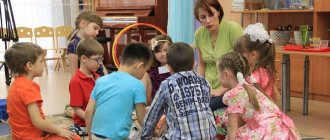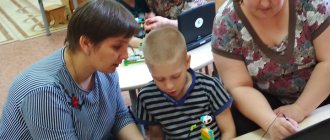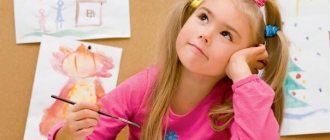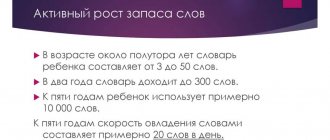What conditions for communication does the game provide for children?
In preschool age, play is the main form of children's activity, the leading activity that stimulates the all-round development of the child. The vast majority of games are designed for partnerships and collective interactions.
If a child wants to express himself in any role, he needs partners; wants to run and jump - needs accomplices in active action.
Such activities involve interaction, communication, communication both with each other and in a group of children.
The game has a set of requirements and characteristics that are directly related to the development of communication.
- The need to establish connections with other children, to communicate something, to ask about something.
- Ability and willingness to work together.
- Opportunities to take the initiative and convince peers to take part in the game or agree with the proposal of a rule, etc.
- Willingness to submit to the demands of the team and change one’s behavior.
- The need to take into account the opinions of others.
- The ability to find your place in the game and communicate during actions.
- Willingness to show attention and emotional support to peers.
- The need to control your behavior, statements, outbursts of emotions.
Communication in a person’s life performs three main functions: information and communication, regulating relationships and ensuring the emotionality of relationships (affective-perceptual). If we analyze the above list, it becomes obvious that for each of the communication functions there is a place for development in the play activities of preschoolers.
Analysis of the personnel management system in the Ladushki kindergarten
The management structure is traditional. The main governing body is the Pedagogical Council, which is headed by the head of the structural unit. Additionally, a creative group has been organized, which includes teachers with II and I qualification categories. Its task is to ensure enriched physical, cognitive, social, aesthetic and speech development of children, based on advanced pedagogical experience and its methodological developments, allowing for correction in the personal development of children through the organization of individual and collective activities based on meaningful communication, taking into account the needs and interests of themselves children.
The kindergarten staff consists of 65 people. The structure by employee categories is presented by the following data:
— Management staff — 2 people
— Teachers — 22 people
— Junior teachers – 20 people
— Technical staff — 21 people.
The largest number of employees have higher education.
In the kindergarten, the staff has a sufficient level of education. The largest number of employees (62%) have secondary specialized education, and only 39% of the staff have higher education. However, there are no workers who do not have any education on the staff of the Ladushki kindergarten.
The age composition of employees is presented in table 2.1
Table 2.1 - Age composition of employees
| Age of employees Proportion of employees, % 12 up to 25 years 13.2 From 25 to 35 years 24.8 From 35 to 45 years 35.6 Over 45 years 26.4 |
The data presented in Table 2.1 show that the institution has the largest number of employees - from 35 to 45 years old; this age group has the largest share in this structure - 35.6%. In second place in terms of the age structure of the personnel are employees over 45 years old. By a small margin - only 2.4%, third place is occupied by the age group of employees from 25 to 35 years. The smallest share in the age structure is occupied by employees under 25 years of age. Depending on the total length of service of employees, the data is presented in Table 2.2
Table 2.2 - Total length of service of employees
| Work experience | Share of employees, % |
| 1 | 2 |
| up to 1 year | 8 |
| From 1 to 5 years | 12,5 |
| From 5 to 10 years | 32,4 |
| From 10 to 20 years | 25,6 |
| From 20 to 30 years | 15,1 |
| Over 30 years | 6,4 |
The data given in Table 2.2 show that the largest share in this personnel structure is occupied by employees with experience from 5 to 10 years (32.4%), In second place in this personnel structure are employees with experience from 10 to 20 years (25. 6%). Third place is occupied by workers with 20 to 30 years of experience (15.1%). Workers with 2 to 5 years of experience have a small share - only 12.5%. Not at all experienced and young specialists occupy a small share in this structure - only 8%. The smallest share belongs to the group of workers with over 30 years of experience. Their share was 6.4%.
In general, based on the analysis, we can say that in the Ladushki kindergarten there is a close-knit team, the average age of which is 40 years, with experience from 10 to 20 years.
The institution strives for unification, standardization and development of uniform approaches to all types of activities in the field of personnel management in all areas. A clear delineation of powers and areas of responsibility between the Human Resources Department and employees is being made, and the development of general corporate regulations and performance standards in all areas of work in the field of personnel management is being considered as one of the means aimed at ensuring this process.
For a full analysis and assessment of the actual state of the personnel management system in the Ladushki kindergarten, a study was conducted. The survey was conducted among the staff of the institution and covered the entire team (65 people). The survey results are shown in Appendix A.
Most often, employees are affected by the following aspects of the personnel management system: 70% - the system of remuneration and labor motivation; 18% - social guarantees and benefits; 10% - career development and training; 2% - other aspects. The results of the survey regarding the implementation of the above provisions are presented in Appendix A.
More than half of those surveyed (56%) are dissatisfied with the existing wages. Also, 42% are dissatisfied with working conditions, which is why many believe that the level of wages does not correspond to working conditions. This is understandable, because In most departments, working conditions are harmful.
Children's play as a medium for the development of all aspects of communication
Let's consider how the conditions of the game provide preschoolers with opportunities to develop communication skills in terms of the basic functions of communication.
Development of information and communication function
If in ordinary conversations children speak without really listening to the other, then the game situation significantly reduces such chaos. A situational business form of communication is emerging.
Whether it is necessary to agree on what game will be played, assign roles or discuss the rules - preschoolers try to listen to the speaker. In a group of children there are always those who interrupt without listening to the end and shout out their suggestions. Other children stop such screamers, ask them to be silent, and order them back: “Let me listen!”
Following the plot, preschoolers strive to perform roles in a way that conveys the nature of the relationship, rather than simply performing actions. Role-playing speech addressed to game partners is actively used. Dialogues often develop between the characters in the plot. This is great communication training.
In older preschool age, the content of the game is often the relationships between people and the rules governing behavior and communication. For example, while pretending to be at school, one of the preschoolers acts as a strict teacher, makes comments to the students, and strictly follows the educational regulations.
Thus, thanks to inclusion in the game, children exchange information, learn a lot of new things, gain experience in effective communication, and have the opportunity to speak out themselves and hear others.
Formation of interaction skills
A preschooler's mastery of the world of relationships largely occurs through imitation of others. The most important practical task for a preschooler is to learn to act together, coordinating his desires and actions with the activities of his peers.
The older the preschooler, the greater his desire to play together. He may even agree to roles that are of little interest to him in order to get involved in collective activities.
It is interesting that other mechanisms then come into play: when choosing a partner within the framework of the plot, children do not want a random choice, but offer to play together with someone with whom they have already established friendly relations or have shown common interests.
As an example, a girl may agree to be not a flight attendant (an attractive role), but a passenger, but at the same time she will invite her friend to be a “passenger”. And only after this will he become much more enthusiastic about playing a role that initially did not arouse much interest.
Plot-based role-playing game creates conditions for children to simultaneously develop role-playing and real-life relationships. In role-playing games they train “as they should,” but in real ones they behave the way they want.
When children speak in accordance with the chosen role, they reflect their ideas about the style and nature of relationships. Every day they see how their parents communicate, how other adults interact, and imitate them in accordance with the game plot.
It is interesting to watch how a preschooler steps out of his role for a minute and begins to express his comments that someone is behaving differently, or that the rules of the game do not correspond to how it happens in life.
Development of the emotional sphere and children’s perception of each other
The situations played out by children are made up for fun, but the feelings experienced in the game are real, real.
In play, a child can express himself in ways that he would not dare to behave in everyday interactions with peers. This is especially true for timid children. Adults who organize or supervise preschoolers’ games should encourage timid children to also take leading roles. This will not only open up the child’s potential, but will also allow other children to see a new side of their peers.
In children's games there is a lot of expression, laughter or violent indignation. The preschooler learns to manage his behavior and emotionality, and masters the moral norms of relationships.
Preschoolers quarrel quite often when playing. Especially at the stage of distributing roles, establishing rules, and developing the plot. The reason for these quarrels is differences in the presentation of actions and the nature of the game. For example, one child believes that their play “store” should copy a self-service supermarket, while another insists that the “salesperson” weighs, accepts “money”, etc.
Those who argue have to compromise and come to an agreement. Otherwise the game will not take place. Moreover, preschoolers resolve such disputes themselves, without turning to adults. This is how they learn to give in, agree with different opinions, cope with resentment, and make their first attempts to analyze their behavior and the actions of other children.
Basic documents regulating the activities of the organization
The institution is guided by the Law of the Russian Federation “On Education”, standard regulations on preschool educational institutions, Legislation of the Russian Federation, Decrees of the President of the Russian Federation, Decrees of the Government of the Russian Federation, regulatory legal acts of the Ministry of Education of the Russian Federation; the regional Law “On the Education of the Sverdlovsk Region”, Decrees of the Government of the Sverdlovsk Region, Decrees of the Governor of the Sverdlovsk Region; regulatory legal acts of educational management bodies, the Charter of “MDOU kindergarten No. 17” (general position, goals, objectives, subject and types of activities of the institution; staffing of the institution; organization of the educational process of the institution; participants in the educational process, their rights and obligations; financial and economic activities institution; procedure for managing the Institution; labor and social protection; liquidation and reorganization of the institution; local acts) and local legal acts of the Institution (-orders and instructions of the head; -internal regulations; -collective agreement; -regulations on the procedure for establishing additional payments and allowances, incentives character at the expense of budgetary and extra-budgetary funds; - regulations on the formation and use of funds from the current extra-budgetary account; - MDOU No. 17 agreement on cooperation with parents, regulations on the council of teachers; - regulations on the parent committee; - decision of the council of teachers of the Institution; instructions on the protection of life and children's health; -staffing schedule; -employee work schedules; - work plans of the institution; etc.).
1.3 Nature of organizational ownership. The institution is a non-profit organization, the property of which is owned by the city district of Revda and belongs to the institution with the right of operational management.
1.4 The effectiveness of the organization. The effectiveness of the organization’s activities is considered through the performance indicators of the preschool educational institution, as an integral system of interaction between participants in the educational process. Based on the educational program of the preschool educational institution, a system for tracking the performance of activities has been developed: the creative achievements of teachers and students.










